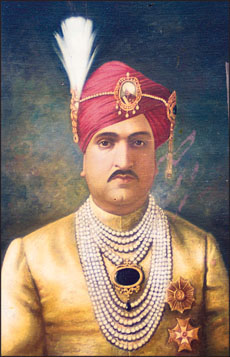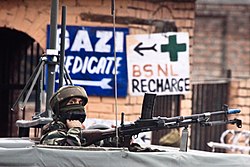Hari Singh had ascended the throne of Kashmir in 1925 and was the reigning monarch at the conclusion of British rule in the subcontinent in 1947. One of the conditions of the partition of India imposed by Britain was that the rulers of princely states would have the right to opt for either Pakistan or India or remain independent. In 1947, Kashmir's population was 77% Muslim and it shared a boundary with both Dominion of Pakistan and Union of India. On 20 October 1947, tribesmen backed by Pakistan invaded Kashmir.[3]

The Maharaja initially fought back but appealed for assistance to the Governor-General Louis Mountbatten, who agreed on the condition that the ruler accede to India.[4] On 25 October 1947 Maharaja Hari Singh signed the Instrument of Accession[5] on 26 October 1947 and it was accepted on 27 October 1947 by the Governor General of India.[6] Once the Instrument of Accession was signed, Indian soldiers entered Kashmir with orders to evict the raiders, but they were not able to expel everyone from the state by the time the harsh winter started. India took the matter to the United Nations. The UN resolution asked both India and Pakistan to vacate the areas they had occupied and hold a referendum under UN observation. The holding of this plebiscite, which India initially supported, was dismissed by India because the 1952 elected Constituent Assembly of Jammu and Kashmir voted in favour of confirming the Kashmir region's accession to India.[7] Another reason for the abandonment of the referendum is because demographic changes after 1947 have been effected in Pakistan-administered Kashmir, as generations of Pakistani individuals non-native to the region have been allowed to take residence in Pakistan-administered Kashmir.[7][8] Furthermore, in Jammu & Kashmir state of India, the demographics of the Kashmir Valley have also been altered after separatist militants coerced 250,000 Kashmiri Hindus to leave the region.[9][10] Moreover, Pakistan failed to withdraw its troops from the Kashmir region as was required under the same U.N. resolution of August 13, 1948 which discussed the plebiscite.[7]
Politics and government
Jammu and Kashmir is the only state in India which enjoys special autonomy under Article 370 of the Constitution of India, according to which no law enacted by the Parliament of India, except for those in the field of defence, communication and foreign policy, will be extendable in Jammu and Kashmir unless it is ratified by the state legislature of Jammu and Kashmir. Subsequently, jurisdiction of the Supreme Court of India over Jammu and Kashmir has been extended.[40]
Jammu and Kashmir is also the only Indian state that has its own flag and constitution, and Indians from other states cannot purchase land or property in the state.[41] Designed by the then ruling National Conference, the flag of Jammu and Kashmir features a plough on a red background symbolizing labour; it replaced the Maharaja's state flag. The three stripes represent the three distinct administrative divisions of the state, namely Jammu, Valley of Kashmir, and Ladakh.[42]


No comments:
Post a Comment